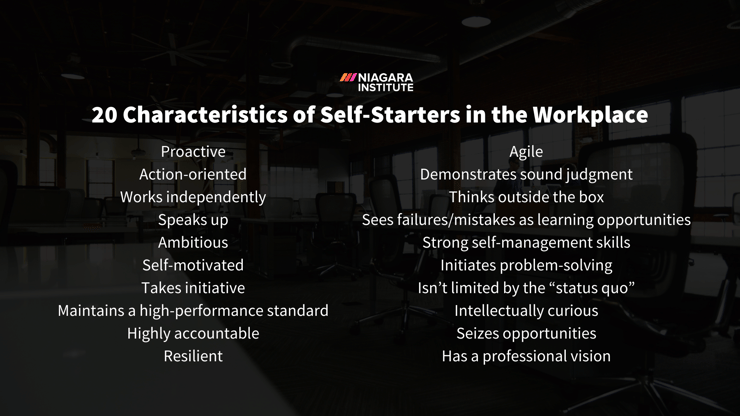7 min read
Leadership Essentials: How to Set Healthy Workplace Boundaries?
It's okay to say no.
3 min read
 Michelle Bennett
:
Sep 22, 2022 5:30:00 AM
Michelle Bennett
:
Sep 22, 2022 5:30:00 AM

Self-starters are a significant asset to any leader and team. They’re the employees who you don’t need to tell to do something because they have already thought of it and have it in hand. Their motivation, resilience, and accountability come from within, and they use them to take action when others may not.
However, self-starters can burn out, overstep boundaries, struggle with boredom, or get frustrated to the point of disengagement or even resignation if they don’t have a strong leader in their corner.
In the following article, we’ll not only outline the identifying characteristics of self-starters so you can determine if you do in fact have one on your team, but we’ll also provide some tips to help you become the strong leader the self-starters in your charge need.
By definition, a self-starter is someone “who begins work or undertakes a project on their own initiative, without needing to be told or encouraged to do so.” Their attitude, skillset, and behaviors set them apart from the crowd in the workplace and, when used in the right situation, can allow them to achieve great things. You will often find that the same individuals you determine to be self-starters are also your high-potential employees.
If you think someone may be a self-starter, consider how many of these 20 characteristics they embody. If the following list describes them, then move on to the next section, where we’ll review how you can lead them effectively.

It can be a joy to lead an employee who gets their job done with minimal supervision, takes initiative, and exceeds your expectations.
However, self-starter employees can also get themselves into trouble if there isn’t someone effectively leading them. Some self-starters can be so keen to make an impact or prove themselves that they ignore workplace boundaries, frustrate or alienate others, take unnecessary risks, and overstep their authority. These behaviors may not be intentional, but it is a reality many leaders of self-starters have and will continue to manage.
It is for that reason that self-starters need strong leadership. They need someone to guide them, keep them in check, and encourage their efforts. They also need their leader to do the following:
With your self-starter employees, it’s crucial to establish and uphold boundaries. These boundaries let your employees know what they can or cannot do without consulting you or first receiving your approval. Then, use your weekly one-on-one meetings to ensure they respect those boundaries and course-correct them if necessary.
Self-starters are eager, ambitious, and thrive off a challenge. While this can be a great thing, it can also mean that they get bored or disengaged faster than other employees. To help avoid this, initiate career conversations with them. Don’t worry; it is highly unlikely that they will suddenly quit if you do. Instead, it will make them feel that someone truly cares about their professional goals, vision, and passions, which can encourage them to work even harder for you. In other words, because you had their back, they’ll have yours.
It’s not enough to just talk to your self-starter employees about their professional goals, vision, and passions; you have to do something with that information. Once you know what your employee wants to achieve or is motivated by, start looking for learning and growth opportunities that align with that, and that will challenge them, like stretch assignments, training, a mentorship arrangement, or a job swap/rotation.
If you want your employees to thrive, not just your self-starters but everyone, you need to create the right environment and team culture. As the Economic Times pointed out, “Some managers reprimand their team members when mistakes happen, push their teams to strictly follow the set processes, and stay within safe limits while carrying out their day-to-day responsibilities. These kinds of workplaces do not help innovation, exploration, and experimentation. Teams do not see any incentive to take initiative and make the first move. They wait for instructions rather than start themselves.”
Just because self-starters have strong self-motivation, it doesn't mean that they don’t appreciate hearing words of encouragement. In fact, self-starters may become resentful over time if they do not hear the words “thank you” enough for their hard work and effort.
Given how eager self-starters are to do well and deliver results, you will likely find them quite coachable. What this means is that they are open to constructive feedback if it means it could help them do something better or avoid a mistake. So, don’t wait to give it to them; instead, provide them with real-time coaching and feedback so they can immediately apply it.
While there will be a select few employees who are naturally self-starters, there are things you can do as a leader to encourage others to adopt some of the characteristics of self-starters. To help them do so, try sending them our guide to self-management and work through it together in your one-on-one meetings!

7 min read
It's okay to say no.

6 min read
Aristotle is famously quoted as saying, “Knowing yourself is the beginning of all wisdom,” and nothing can be more accurate regarding leadership....

5 min read
Have you noticed the get-up and go has got up and went for one or many of your employees? If so, you’re not alone. Many leaders across all industries...